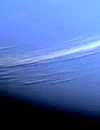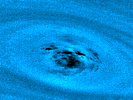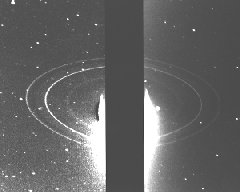 Voyager reached Neptune on 26 August 1989. Its final targets were Neptune
and its collection of moons. The largest of them, Triton, had long been
expected to be one of the most extraordinary places in the solar system.
Members of NASA imaging team were delighted but baffled. Triton and Neptune
turned out to be active and violent worlds.
Now they had to work out why.
Voyager reached Neptune on 26 August 1989. Its final targets were Neptune
and its collection of moons. The largest of them, Triton, had long been
expected to be one of the most extraordinary places in the solar system.
Members of NASA imaging team were delighted but baffled. Triton and Neptune
turned out to be active and violent worlds.
Now they had to work out why.
 The
interior of the planet begins with a region of heavily compressed gases.
Deep in the interior, these gases blend into a liquid layer that surrounds
the planet's central core of rock and ice. The tilt of Neptune's axis causes
the sun to heat the planet's northern and southern hemispheres resulting
in seasons and temperature changes. Neptune is surrounded by thick layers
of clouds in rapid motion. Winds blow these clouds at speed up to 1,100
kilometres per hour. The clouds farthest from Neptune's surface consist
mainly of methane. Neptune's dark clouds, which lie below the clouds of
methane are composed of hydrogen sulphide.
The
interior of the planet begins with a region of heavily compressed gases.
Deep in the interior, these gases blend into a liquid layer that surrounds
the planet's central core of rock and ice. The tilt of Neptune's axis causes
the sun to heat the planet's northern and southern hemispheres resulting
in seasons and temperature changes. Neptune is surrounded by thick layers
of clouds in rapid motion. Winds blow these clouds at speed up to 1,100
kilometres per hour. The clouds farthest from Neptune's surface consist
mainly of methane. Neptune's dark clouds, which lie below the clouds of
methane are composed of hydrogen sulphide.

 A
dark region about the size of the earth called the Great Dark Spot, consist
of violently swirling masses of gas that resemble a hurricane. The high
winds and the shape of the Great Dark Spot are similar to those of the Great
Red Spot on Jupiter.
A
dark region about the size of the earth called the Great Dark Spot, consist
of violently swirling masses of gas that resemble a hurricane. The high
winds and the shape of the Great Dark Spot are similar to those of the Great
Red Spot on Jupiter.
 Observations
from the earth had shown that Neptune, instead
Observations
from the earth had shown that Neptune, instead of having completed rings, has ring arcs - fragments of rings. But Neptune
turned out to have complete rings after all. They are so faint that they
would be invisible even to the person who was actually there. In addition
to the rings, there is a faint layer of dust stretching from near the surface
of Neptune to the two bright outer rings.The rings of Neptune are made of
billions of
of having completed rings, has ring arcs - fragments of rings. But Neptune
turned out to have complete rings after all. They are so faint that they
would be invisible even to the person who was actually there. In addition
to the rings, there is a faint layer of dust stretching from near the surface
of Neptune to the two bright outer rings.The rings of Neptune are made of
billions of independently orbiting moonlets varying from boulders to single atoms like
a chain of endless train cars. For some reason the moonlets appear to have
bunched together. That is why we see the arcs. All the moons of the giant
planets confine the rings and prevent them from getting away into space.
But no such relation was discovered between Neptune and its moons. By looking
back towards the sun, Voyager captured light being scattered by Neptune's
tenuous charcoal-dark rings. Ring movements smeared another image of one
of the arcs showing that they hold knots of accumulated particles.
independently orbiting moonlets varying from boulders to single atoms like
a chain of endless train cars. For some reason the moonlets appear to have
bunched together. That is why we see the arcs. All the moons of the giant
planets confine the rings and prevent them from getting away into space.
But no such relation was discovered between Neptune and its moons. By looking
back towards the sun, Voyager captured light being scattered by Neptune's
tenuous charcoal-dark rings. Ring movements smeared another image of one
of the arcs showing that they hold knots of accumulated particles.
Graphics, photographs and statistical data used by the courtesy of NASA and National Geographic Magazine